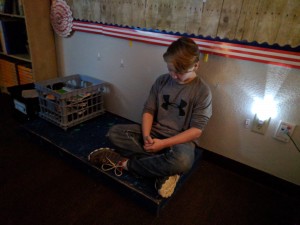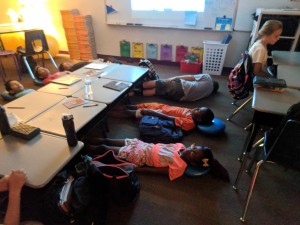I came home in a serious funk, slamming the door behind me, barking at my family, huffing and puffing under the heavy weight of the stack of papers I bring home (optimistically) every evening. I sat down on my bed and began reflecting. Why was I feeling so angry, anxious, and upset? I had connected well with my students that day, had gotten a lot accomplished, and our lessons felt spectacularly successful. I rifled back through what felt like a typical school day beginning with an early morning parent/teacher conference. It was a difficult meeting as we searched for ways to reach an emotionally and physically abused and neglected student, who is in a safe environment now and eager to learn, but struggles from years of educational neglect and trauma that will last a lifetime. Later a student came to me in tears as he told me about accidentally leaving his folder at his dad’s house and how he is struggling with the fresh reality of his parent’s impending divorce. After school, a student caught me on my way out to ask for extra granola bars he knew I kept stashed in my room because his siblings were hungry and their mom was out of town. My mood started to make sense.
Everyone has heard of the opportunity cost of teaching – the monetary gap due to choosing to teach over a more remunerative career. The average elementary school teacher in the United States earns about 67 percent of the salary of an average college-educated worker in the United States. But there’s an additional opportunity cost of teaching. It’s truly an occupational hazard: stress and vicarious trauma.
Teachers today are remarkably stressed (Kyriacou, 2001, p. 29) and experiencing vicarious trauma contributes to it. In a recent study published in the Journal of Positive Behavior Interventions, over 93% of elementary teachers report feeling a high level of stress. Over my nineteen years of classroom teaching, I have frequently and increasingly felt stress lead to the raw, rundown burden of burnout. Physical and emotional abuse, hunger, divorce, suicidal thoughts, drug or alcohol abuse in the home, and bullying- it hurts to see my students in pain. I have noted the wear and tear on my own mental health.
Burnout can be described as “a chronic state of exhaustion due to long-term interpersonal stress within human service professions. It pertains to feelings experienced by people whose jobs require repeated exposure to emotionally charged social situations” (Schwarzer & Hallum, 2008, pg. 155). Many of the difficulties that we encounter in the classroom are “emotionally charged.” Larger class sizes and more responsibilities lead to increasing workloads. Lack of support outside of the classrooms continue to isolate teachers while demanding more of us. A significant rise in violent behaviors and emotional and physical outbursts in schools and classrooms lead to additional stress and actual trauma.
A recent CDC study shows that more than 50% of students have experienced one or more adverse childhood events (ACE). ACEs can be physical, sexual, verbal abuse, physical and emotional neglect, a parent who’s an alcoholic (or addicted to other drugs) or diagnosed with a mental illness, losing a parent to abandonment or divorce, and a family member in jail. More than half of our students in today’s classrooms are dealing with trauma that I, as an adult, do not feel prepared to handle, let alone help 10-15 little people navigate, while also trying to help them master rigorous learning standards.
So what can classroom teachers do for students who are suffering from trauma?
- Recognize that trauma changes the brain. You may need to change the way you speak, act and react to students experiencing trauma.
- Use your classroom environment. Set clear expectations and stick to consistent routines and schedules.
- Understand that you may be teaching children with a different emotional age than their chronological age. Remembering that simple fact often is enough to release extra patience and grace when I’m dealing with a heated struggle or difficult situation with a student.
- Try practicing mindfulness in the classroom. It will help your students and you decrease stress and anxiety.


- Build relationships. It is critical for your understanding of your students and their need to feel secure and safe. Knowing their stories and background can be hard but it is crucial.
Equally important, what can teachers do for ourselves if we are suffering stress or vicarious trauma?
- In or after an emotionally charged moment with a student, give yourself permission to hit reset. Work with another student, get a drink of water or eat a snack (preferably chocolate – seriously, there’s research on this), and take a deep breath.
- Do things that you love and practice self-care daily. That day, listing the items and tasks that amount to a now-typical work day, I felt my heart beat faster, prickles of anxiety race up my spine, and my chest start to constrict painfully. So I went for a hike and did some yoga because I know that is my remedy for feeling better, physically and emotionally. Do whatever self-care you require so you can continue to care for others.

- Ask for help. Rely on your peers and administration.
- Demand more by advocating for your students. In my personal experience, advocacy is a great remedy for anxiety and burnout. Speaking to a board member, member of the legislature or even a neighbor about the effects of ACEs, the lack of psychologists and social workers in today’s schools, and the impact of stress and vicarious trauma on teachers can help. Doing something to help the situation often makes you feel better, even if the result is not what you sought.
- Some teachers believe they have begun to show PTSD-like symptoms from work and researchers are just beginning to investigate this phenomenon. 27% of teachers in a recent study do not feel safe at school as they have been bullied, threatened, or assaulted (American Federation of Teachers, 2017, pg. 4). If that sounds like you, seek professional help.
As I write this, I reflect on the other, more insidious opportunity cost of teaching. After doing this job for a long time, I generally find the right balance for me to continue teaching. I even continue to love it (most days). I realize that our students need us, now more than ever.










Comments 8
I’ve got more mental health issues this year than even before. I know I’m not the only one who brings every interaction home with me on a daily basis, so it’s nice to be reminded to take care of myself too. Luckily I’ve got the people in my corner; my colleagues let me vent when I need to, and my boyfriend reminds me how amazing I am (even when I don’t feel it).
Oh, Rachel! I hear you! It’s so hard not to bring it all home when our students live in our hearts. I’m glad you have a good support system. I know I couldn’t do this job without the support of my husband, my family, friends and my fabulous colleagues. One of my friends responded to my post on Facebook that we as teachers need school counselors, too, and I totally agree!
Great piece. Teachers need training about Compassion Fatigue and intentional strategies to protect our own mental health so that we may continue to serve youth in our community. It’s so strange that teachers get little training and discussion about this topic when other fields like counselors are better prepared. I think it’s important that teachers keep the dialogue going about this topic to train each other. This is such a resourceful piece Thank you!
Thank you!
Thanks, Jess! Totally agree – it is very strange that we receive little to no training. I hope this dialogue helps!
This piece really resonates. This year my introduction level ELD class has gone from what is usually a class of 15-18 kids, to, at this point 27. We usually get more in January. Many are coming from some pretty bad situations in Central America, some are living with aunts or uncles instead of parents, and all of them have a story. I do not always get the full story due to language barriers (and/or a student’s reluctance to share everything) but their needs come out in various ways through interactions with teachers and other students. Trying to navigate the interpersonal drama and classroom management as new students enter our community throughout the semester has become as time consuming as planning for instruction, and definitely more stressful and heart-wrenching. Thanks for writing on this difficult topic.
Wow, Amethyst! That is a lot of students for ANY classroom, let alone an ELD classroom of students, many of whom are refugees! I hope you are practicing self-care. Your students and profession need a champion like you.
I never imagined that teaching would be as stressful as it is today. It’s hard not to be affected by the trauma my students experience, which is where self care becomes so important. I try to find exercise classes that I enjoy and commit to going to them as often as possible – it really helps!
I think that is a great technique for self-care, Caitlin! And I agree – I believe teaching was not this stressful, even as little as 8-10 years ago.